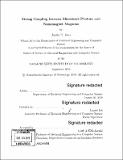| dc.contributor.advisor | Luqiao Liu. | en_US |
| dc.contributor.author | Hou, Justin T.(Justin Tony) | en_US |
| dc.contributor.other | Massachusetts Institute of Technology. Department of Electrical Engineering and Computer Science. | en_US |
| dc.date.accessioned | 2020-03-09T18:53:43Z | |
| dc.date.available | 2020-03-09T18:53:43Z | |
| dc.date.copyright | 2019 | en_US |
| dc.date.issued | 2019 | en_US |
| dc.identifier.uri | https://hdl.handle.net/1721.1/124105 | |
| dc.description | Thesis: S.M., Massachusetts Institute of Technology, Department of Electrical Engineering and Computer Science, 2019 | en_US |
| dc.description | Cataloged from PDF version of thesis. | en_US |
| dc.description | Includes bibliographical references (pages 59-66). | en_US |
| dc.description.abstract | Coupled microwave photon-magnon hybrid systems offer promising applications by harnessing various magnon physics. At present, in order to realize high coupling strength between the two subsystems, bulky ferromagnetic insulators with large spin numbers are utilized, which limit their potential applications for scalable quantum information processing. In this thesis, by enhancing single spin coupling strength using lithographically defined superconducting resonators, we demonstrate high cooperativities between a resonator mode and a Kittel mode in nanometer thick Permalloy wires. Strong magnon-photon coupling is achieved with number of spins in the order of 1013, three orders of magnitude lower compared with previous studies. Moreover, we confirm the scaling law of coupling strength as a function of spin numbers. The experimental single spin-photon coupling strengths are extracted, which attain reasonable agreement with values derived from our quantum mechanical model. Our model therefore provides a guideline for further scaling down of the magnonic volume, which indicates that the number of spins for reaching strong coupling can be reduced to 104 with optimized material and resonator design. The realization of the coupled systems using metallic ferromagnets with conventional Si-substrates demonstrates a highly engineerable and industrial compatible on-chip device design, which opens up the possibility to investigate magnon-photon coupling in a wide range of spintronic devices, such as magnetic tunnel junctions. Our results provide a novel platform of magnon-photon coupled systems, where the interplay of spintronics, light-matter interaction, and quantum information science can be studied in an on-chip and lithographically scalable architecture. | en_US |
| dc.description.statementofresponsibility | by Justin T. Hou. | en_US |
| dc.format.extent | 66 pages | en_US |
| dc.language.iso | eng | en_US |
| dc.publisher | Massachusetts Institute of Technology | en_US |
| dc.rights | MIT theses are protected by copyright. They may be viewed, downloaded, or printed from this source but further reproduction or distribution in any format is prohibited without written permission. | en_US |
| dc.rights.uri | http://dspace.mit.edu/handle/1721.1/7582 | en_US |
| dc.subject | Electrical Engineering and Computer Science. | en_US |
| dc.title | Strong coupling between microwave photons and nanomagnet magnons | en_US |
| dc.type | Thesis | en_US |
| dc.description.degree | S.M. | en_US |
| dc.contributor.department | Massachusetts Institute of Technology. Department of Electrical Engineering and Computer Science | en_US |
| dc.identifier.oclc | 1142635534 | en_US |
| dc.description.collection | S.M. Massachusetts Institute of Technology, Department of Electrical Engineering and Computer Science | en_US |
| dspace.imported | 2020-03-09T18:53:42Z | en_US |
| mit.thesis.degree | Master | en_US |
| mit.thesis.department | EECS | en_US |
